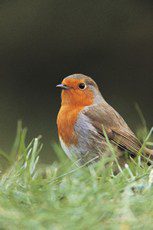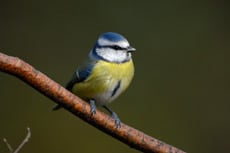Half a million people are expected to watch and count their garden birds for the 2018 RSPB Big Garden Birdwatch this January.

The world’s largest garden wildlife survey, now in its 39th year, takes place between 27 and 29 January, when the public is asked to spend just one hour on any of those days, watching and recording the birds that they see in their garden or local green space.
Close to half-a-million people took part in the Big Garden Birdwatch in 2017 counting more than eight million birds and providing valuable information about the wildlife using our gardens in winter. The house sparrow remained top of the rankings in Scotland, with starlings and chaffinches rounding off the top three. [Note 2]
Last year’s Big Garden Birdwatch also revealed an explosion in the number of recorded sightings of waxwings. These attractive looking birds flock to UK gardens in winter once every 7-8 years when the berry crop fails in their native Scandinavia. Known as an ‘irruption’, results showed that waxwings were seen in around nine times more Scottish gardens in 2017 compared to previous years.
Daniel Hayhow, RSPB Conservation Scientist said: “The birds we see in our garden are often the first experience we have with nature – whether it’s a flock of starlings at the feeder, a robin perched on the fence or some house sparrows splashing in the bird bath. But it may come as a surprise to know that some of our most-loved species are in desperate need of our help as their numbers have dropped dramatically.
“The Big Garden Birdwatch is a great opportunity to get involved with helping our garden wildlife. By counting the birds that visit your outdoor space, you’ll be joining a team of over half-a-million people across the UK who are making a difference for nature. It only takes an hour so grab a cuppa, sit back and see who makes a flying visit to your garden.
“With over half a million people now regularly taking part, coupled with nearly 40 years’ worth of data, Big Garden Birdwatch allows us to monitor trends and helps us understand how birds are doing. With results from so many gardens, we are able to create a ‘snapshot’ of the birds visiting at this time of year across the UK. Even if you see nothing during your Big Garden Birdwatch hour, that’s important information too, so please let us know.”
As well as counting birds, the RSPB is once again asking participants to log some of the other wildlife they might have seen in their gardens throughout the year, including animals like hedgehogs, which will currently be hibernating. Up to 15 species can be recorded in total, including red squirrels, foxes and toads.
To take part in the Big Garden Birdwatch 2018, all you need to do is watch the birds in your garden or local park for one hour at some point during January 27-29. Count the birds that land, not ones flying over, and tell us the highest number of each bird species you see at any one time – not the total you see in the hour. Results can then be submitted at www.rspb.org.uk/birdwatch.
The parallel event, Big Schools’ Birdwatch, has already begun and runs until 23 February. Over 6,300 school children in Scotland spent an hour in nature counting birds in 2017’s survey, with blackbirds remaining the most common playground visitor followed by carrion crows and starlings. Further information can be found at www.rspb.org.uk/schoolswatch
Big Garden Birdwatch and Big Schools’ Birdwatch are part of the RSPB Giving Nature a Home campaign, aimed at tackling the house crisis facing the UK’s threatened wildlife. The charity is asking people to provide a place for wildlife in their gardens or outdoor spaces – whether it’s putting up a nest box for birds, creating a pond for frogs or building a home for hedgehogs.






